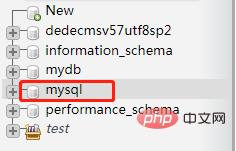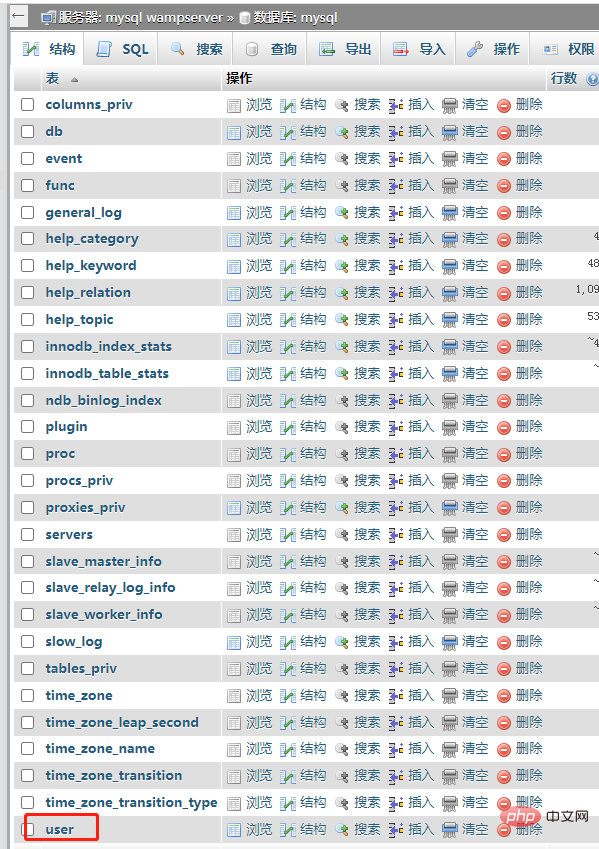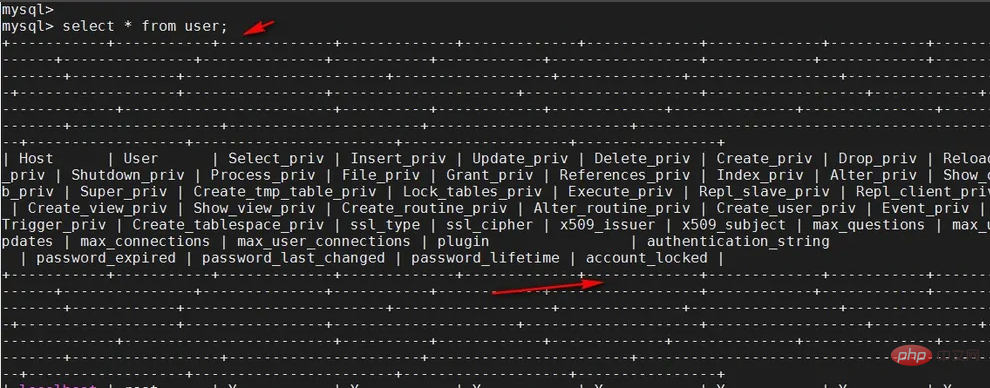Where is the user table of mysql?
The user table is in the database named "mysql". MySQL will automatically create a database named "mysql" during installation. The mysql database stores user permission tables; the user table is the most important permission table in the mysql database and is used to record the accounts allowed to connect to the server. information. All permissions enabled in the user table are global and apply to all databases.

The operating environment of this tutorial: windows7 system, mysql8 version, Dell G3 computer.
The user table is in the database named "mysql".
MySQL will automatically create a database named mysql during installation. The mysql database stores user permission tables. After the user logs in, MySQL will grant corresponding permissions to each user based on the contents of these permission tables.
The user table is the most important permission table in MySQL, used to record account information allowed to connect to the server. It should be noted that all permissions enabled in the user table are global and apply to all databases.


Fields in the user table
The fields in the user table can be roughly divided into There are 4 categories, namely user columns, permission columns, security columns and resource control columns. The following mainly introduces the meaning of these fields.
User column
The user column stores the information that users need to enter when connecting to the MySQL database. It should be noted that MySQL 5.7 version no longer uses Password as the password field, but changed it to authentication_string.
The user list for MySQL version 5.7 is shown in Table 1.
| Field name | Field type | Is it empty | Default value | Description |
|---|---|---|---|---|
| Host | char(60) | NO | None | Host Name |
| User | char(32) | NO | None | Username |
| authentication_string | text | YES | None | Password |
When a user logs in, the MySQL database system will only allow him or her to log in if these three fields match at the same time. When creating a new user, the values of these three fields are also set. When you modify a user's password, you actually modify the value of the authentication_string field of the user table. Therefore, these 3 fields determine whether the user can log in.
Permission column
The fields in the permission column determine the user's permissions and are used to describe the operations allowed on data and databases in the global scope.
Permissions are roughly divided into two categories, namely advanced management permissions and ordinary permissions:
- Advanced management permissions mainly manage the database, such as the permission to close services, super permissions and Load users, etc.;
- Normal permissions mainly operate the database, such as query permissions, modify permissions, etc.
The permission columns of the user table include Select_priv, Insert_ priv and other fields ending with priv. The data type of these field values is ENUM. The only possible values are Y and N: Y means that the user has corresponding Permissions, N means that the user does not have corresponding permissions. For security reasons, the default value for these fields is N.
| Field name | Field type | Is it empty | Default value | Description |
|---|---|---|---|---|
| enum('N','Y') | NO | N | Whether it is possible to query data through the SELECT command | |
| enum('N','Y') | NO | N | Whether data can be inserted through the INSERT command | |
| enum('N','Y' ) | NO | N | Can existing data be modified through the UPDATE command? | |
| enum ('N','Y') | NO | N | Can you delete existing data through the DELETE command? | |
| enum('N','Y') | NO | N | Can create new databases and tables | |
| enum('N','Y') | NO | N | Can I delete an existing database? and table | |
| enum('N','Y') | NO | N | Is it possible to execute specific commands that refresh and reload the various internal caches used by MySQL, including logs, permissions, hosts, queries, and tables | |
| enum( 'N','Y') | NO | N | Whether it is possible to shut down the MySQL server. Extreme caution should be exercised when providing this privilege to any user other than the root account | |
| enum('N','Y') | NO | N | Can I check the processes of other users through the SHOW PROCESSLIST command? | |
| enum(' N','Y') | NO | N | Whether it is possible to execute the SELECT INTO OUTFILE and LOAD DATA INFILE commands | |
| enum('N','Y') | NO | N | Can I grant my permissions to other users? | |
| enum('N','Y') | NO | N | Can create external Key constraints | |
| enum('N','Y') | NO | N | Whether it is possible to perform addition and deletion checks on the index | |
| enum('N','Y') | NO | N | Can the table structure be renamed and modified | |
| enum('N','Y') | NO | N | Is it possible to view the names of all databases on the server, including databases to which the user has sufficient access rights | |
| enum('N','Y') | NO | N | Whether it is possible to perform some powerful management functions, such as deleting user processes through the KILL command; use The SET GLOBAL command modifies global MySQL variables and executes various commands regarding replication and logging. (Super permission) | |
| enum('N','Y') | NO | N | Is it possible to create a temporary table | |
| enum('N','Y') | NO | N | Is it possible to use the LOCK TABLES command to prevent access/modification of tables | |
| enum('N','Y') | NO | N | Can the stored procedure be executed? | |
| enum('N',' Y') | NO | N | Is it possible to read the binary log file used to maintain a replicated database environment | |
| enum('N','Y') | NO | N | Is it possible to determine the location of the replication slave server and master server | |
| enum('N','Y') | NO | N | Can a view be created? | |
| enum('N','Y') | NO | N | Yes Can view view | |
| enum('N','Y') | NO | N | Whether stored procedures and functions can be changed or discarded | |
| enum('N','Y') | NO | N | Whether stored functions and functions can be modified or deleted | |
| enum('N','Y') | NO | N | Whether it is possible to execute the CREATE USER command, which is used to create a new MySQL account | |
| enum('N','Y') | NO | N | Whether events can be created, modified and deleted | |
| enum('N','Y') | NO | N | Whether triggers can be created and deleted | |
| enum('N','Y') | NO | N | Can the table be created? space |
| Field name | Field type | Whether it is empty | Default value | Description |
|---|---|---|---|---|
| enum('','ANY','X509','SPECIFIED') | NO | Support ssl standard encryption security field | ||
| blob | NO | Support ssl standard encryption security field | ||
| blob | NO | Support x509 standard fields | ||
| blob | NO | Support x509 Standard fields | ||
| char(64) | NO | mysql_native_password | Introducing plugins for user Password verification when connecting, plugin creates external/proxy user | |
| enum('N','Y') | NO | N | Whether the password has expired (N has not expired, y has expired) | |
| timestamp | YES | Record the time when the password was last modified | ||
| smallint(5) unsigned | YES | Set the validity time of the password in days | ||
| enum('N','Y') | NO | N | Whether the user is locked (Y locked, N unlocked) |
Resource control column
The fields of the resource control column are used to limit the resources used by users. The resource control columns in the user table are shown in Table 4.| Field type | Yes Is empty | Default value | Description | |
|---|---|---|---|---|
| int(11) unsigned | NO | 0 | Specifies the number of query operations allowed per hour | |
| int(11) unsigned | NO | 0 | Specifies the number of update operations allowed per hour | |
| int(11) unsigned | NO | 0 | Specifies the number of connection operations allowed per hour | |
| int(11) unsigned | NO | 0 | Specifies the number of connections allowed to be established simultaneously |
How to access the user table
1. Connect to the mysql database and view all default database information





mysql video tutorial]
The above is the detailed content of Where is the user table of mysql?. For more information, please follow other related articles on the PHP Chinese website!

Hot AI Tools

Undresser.AI Undress
AI-powered app for creating realistic nude photos

AI Clothes Remover
Online AI tool for removing clothes from photos.

Undress AI Tool
Undress images for free

Clothoff.io
AI clothes remover

AI Hentai Generator
Generate AI Hentai for free.

Hot Article

Hot Tools

Notepad++7.3.1
Easy-to-use and free code editor

SublimeText3 Chinese version
Chinese version, very easy to use

Zend Studio 13.0.1
Powerful PHP integrated development environment

Dreamweaver CS6
Visual web development tools

SublimeText3 Mac version
God-level code editing software (SublimeText3)

Hot Topics
 1377
1377
 52
52
 MySQL: The Ease of Data Management for Beginners
Apr 09, 2025 am 12:07 AM
MySQL: The Ease of Data Management for Beginners
Apr 09, 2025 am 12:07 AM
MySQL is suitable for beginners because it is simple to install, powerful and easy to manage data. 1. Simple installation and configuration, suitable for a variety of operating systems. 2. Support basic operations such as creating databases and tables, inserting, querying, updating and deleting data. 3. Provide advanced functions such as JOIN operations and subqueries. 4. Performance can be improved through indexing, query optimization and table partitioning. 5. Support backup, recovery and security measures to ensure data security and consistency.
 How to create navicat premium
Apr 09, 2025 am 07:09 AM
How to create navicat premium
Apr 09, 2025 am 07:09 AM
Create a database using Navicat Premium: Connect to the database server and enter the connection parameters. Right-click on the server and select Create Database. Enter the name of the new database and the specified character set and collation. Connect to the new database and create the table in the Object Browser. Right-click on the table and select Insert Data to insert the data.
 Can I retrieve the database password in Navicat?
Apr 08, 2025 pm 09:51 PM
Can I retrieve the database password in Navicat?
Apr 08, 2025 pm 09:51 PM
Navicat itself does not store the database password, and can only retrieve the encrypted password. Solution: 1. Check the password manager; 2. Check Navicat's "Remember Password" function; 3. Reset the database password; 4. Contact the database administrator.
 MySQL: Simple Concepts for Easy Learning
Apr 10, 2025 am 09:29 AM
MySQL: Simple Concepts for Easy Learning
Apr 10, 2025 am 09:29 AM
MySQL is an open source relational database management system. 1) Create database and tables: Use the CREATEDATABASE and CREATETABLE commands. 2) Basic operations: INSERT, UPDATE, DELETE and SELECT. 3) Advanced operations: JOIN, subquery and transaction processing. 4) Debugging skills: Check syntax, data type and permissions. 5) Optimization suggestions: Use indexes, avoid SELECT* and use transactions.
 How to view database password in Navicat for MariaDB?
Apr 08, 2025 pm 09:18 PM
How to view database password in Navicat for MariaDB?
Apr 08, 2025 pm 09:18 PM
Navicat for MariaDB cannot view the database password directly because the password is stored in encrypted form. To ensure the database security, there are three ways to reset your password: reset your password through Navicat and set a complex password. View the configuration file (not recommended, high risk). Use system command line tools (not recommended, you need to be proficient in command line tools).
 How to create a new connection to mysql in navicat
Apr 09, 2025 am 07:21 AM
How to create a new connection to mysql in navicat
Apr 09, 2025 am 07:21 AM
You can create a new MySQL connection in Navicat by following the steps: Open the application and select New Connection (Ctrl N). Select "MySQL" as the connection type. Enter the hostname/IP address, port, username, and password. (Optional) Configure advanced options. Save the connection and enter the connection name.
 MySQL and SQL: Essential Skills for Developers
Apr 10, 2025 am 09:30 AM
MySQL and SQL: Essential Skills for Developers
Apr 10, 2025 am 09:30 AM
MySQL and SQL are essential skills for developers. 1.MySQL is an open source relational database management system, and SQL is the standard language used to manage and operate databases. 2.MySQL supports multiple storage engines through efficient data storage and retrieval functions, and SQL completes complex data operations through simple statements. 3. Examples of usage include basic queries and advanced queries, such as filtering and sorting by condition. 4. Common errors include syntax errors and performance issues, which can be optimized by checking SQL statements and using EXPLAIN commands. 5. Performance optimization techniques include using indexes, avoiding full table scanning, optimizing JOIN operations and improving code readability.
 How to execute sql in navicat
Apr 08, 2025 pm 11:42 PM
How to execute sql in navicat
Apr 08, 2025 pm 11:42 PM
Steps to perform SQL in Navicat: Connect to the database. Create a SQL Editor window. Write SQL queries or scripts. Click the Run button to execute a query or script. View the results (if the query is executed).




